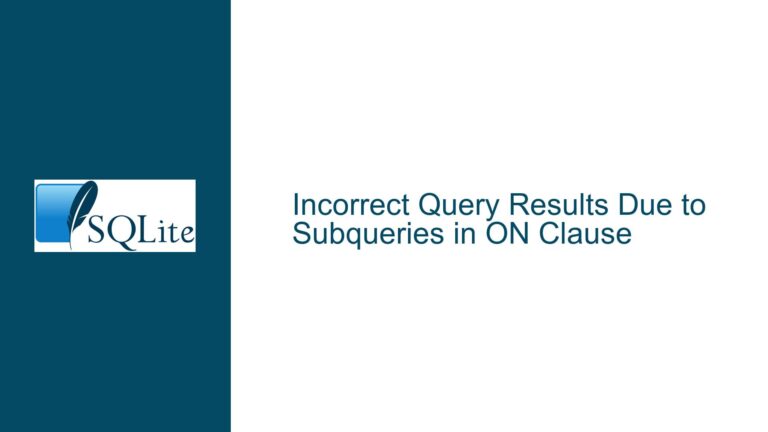Unexpected RIGHT JOIN Behavior with Row-Value Comparisons in SQLite
Unexpected NULL Evaluations in RIGHT JOIN Queries with Row-Value Comparisons
The core issue involves unexpected results when using row-value comparisons (e.g., (col1, col2) = (val1, val2)) in the WHERE clause of a RIGHT JOIN query. This manifests in two distinct but related scenarios:
- Inconsistent NULL Handling: A
WHEREclause comparing a row-value expression to a tuple containingNULLand other values may return rows even when the comparison evaluates toNULL(which is treated as "false" in SQLite’s filtering logic). - Discrepancy Between Projection and Filtering: When the same row-value comparison is used in the
SELECTlist versus theWHEREclause, the former returnsNULL(as expected), while the latter incorrectly includes rows that should be excluded.
Key Observations from Test Cases
Test Case 1 (RTree Virtual Table):
CREATE VIRTUAL TABLE rt0 USING rtree(c0, c1, c2); CREATE TABLE t1(c0); INSERT INTO rt0(c1, c2) VALUES (x'01', x'02'); -- Returns 1 row with (1, 0.0, 0.0) SELECT * FROM t1 RIGHT OUTER JOIN rt0; -- Returns NULL SELECT ((null, false)==(rt0.c0, rt0.c2)) FROM t1 RIGHT OUTER JOIN rt0; -- Incorrectly returns 1 row despite WHERE clause evaluating to NULL SELECT * FROM t1 RIGHT OUTER JOIN rt0 WHERE ((null, false)==(rt0.c0, rt0.c2));The third query returns a row even though the
WHEREclause should filter it out.Test Case 2 (Standard Tables):
CREATE TABLE t1(id INTEGER PRIMARY KEY, x INT); CREATE TABLE t2(y INT); INSERT INTO t1(id,x) VALUES(1, 0); -- Returns no rows (correct) SELECT * FROM t2 RIGHT JOIN t1 ON true WHERE (+id,x)=(99,0); -- Returns 1 row (incorrect) SELECT * FROM t2 RIGHT JOIN t1 ON true WHERE (id,x)=(99,0);The second
SELECTincorrectly returns a row when using a direct row-value comparison.
Critical Context: SQLite’s Three-Valued Logic
SQLite uses three-valued logic (TRUE, FALSE, NULL). In WHERE clauses, only rows where the condition evaluates to TRUE are included. However, this behavior breaks down in the presence of row-value comparisons and RIGHT JOIN due to internal optimizations and type handling.
Root Causes of Incorrect Row-Value Handling in RIGHT JOIN WHERE Clauses
1. Type Affinity Mismatch in Row-Value Comparisons
SQLite’s rtree virtual tables store data with specific type affinities (e.g., c0, c1, c2 in rt0 are stored as REAL). When comparing values of different types (e.g., BLOB literals like x'01' vs. REAL columns), implicit type conversions occur. However, NULL in row-value comparisons bypasses these checks, leading to incorrect evaluations.
In the first test case:
rt0.c1andrt0.c2areREALcolumns.- The inserted values
x'01'andx'02'areBLOBliterals. - The comparison
(null, false)==(rt0.c0, rt0.c2)mixesNULL(unknown type) withREALandBOOLEANvalues, causing the entire expression to evaluate toNULL.
2. RIGHT JOIN Semantics and NULL Propagation
A RIGHT JOIN preserves all rows from the right table, filling in NULL for unmatched left table columns. When the left table (t1 or t2 in the examples) is empty or has no matching rows, all columns from the left table are NULL. This interacts poorly with row-value comparisons:
- Optimizer Short-Circuiting: SQLite’s query optimizer may incorrectly short-circuit row-value comparisons when one operand is a
NULLliteral, treating the entire comparison asNULLwithout evaluating all components. - Lazy Evaluation in WHERE Clauses: The
WHEREclause is evaluated after constructing theJOINresult. If the row-value comparison involvesNULLliterals or columns from the left table (which areNULLin aRIGHT JOIN), the comparison may be misoptimized.
3. Internal Representation of Row-Values
SQLite represents row-values as ephemeral BLOB structures during query execution. When a row-value comparison includes a NULL literal, the internal type-checking logic fails to propagate the NULL correctly, especially when the other operand is a column from a virtual table (e.g., rtree).
4. Version-Specific Bugs in Query Optimization
The bug was present in SQLite 3.39.0 (commit f6d6f969) and earlier. The optimizer’s handling of row-value comparisons in outer joins had a flaw where:
- Comparisons involving
NULLliterals and non-NULLcolumns were not fully evaluated. - The
WHEREclause filter was applied before finalizing theJOINresult in some cases.
Resolving RIGHT JOIN and Row-Value Comparison Anomalies in SQLite
Step 1: Verify SQLite Version and Patches
- Check Version:
SELECT sqlite_version();If the result is
3.39.0or earlier, the bug exists. - Upgrade to Fixed Versions: The fix was implemented in SQLite trunk after commit
f6d6f969. Use a nightly build or version 3.39.1+.
Step 2: Rewrite Row-Value Comparisons for Type Consistency
Avoid mixing NULL literals with columns of different type affinities. Instead of:
SELECT * FROM t1 RIGHT JOIN rt0 WHERE (NULL, false) = (rt0.c0, rt0.c2);
Use explicit type casts or COALESCE:
SELECT * FROM t1 RIGHT JOIN rt0
WHERE (CAST(NULL AS REAL), false) = (rt0.c0, rt0.c2);
Step 3: Use Explicit IS NOT DISTINCT FROM for NULL-Safe Comparisons
SQLite does not natively support IS NOT DISTINCT FROM, but you can emulate it:
SELECT * FROM t2 RIGHT JOIN t1 ON true
WHERE (id = 99 AND x = 0) OR (id IS NULL AND x IS NULL);
This forces a component-wise comparison, avoiding incorrect NULL handling.
Step 4: Avoid Row-Value Comparisons in RIGHT JOIN WHERE Clauses
Refactor queries to move row-value logic to ON clauses or use subqueries:
SELECT * FROM t2 RIGHT JOIN t1 ON (id, x) = (99, 0);
Step 5: Disable Faulty Optimizations with PRAGMA Settings
Temporarily disable the query optimizer’s short-circuiting:
PRAGMA optimize = 0x0000;
Note: This is a diagnostic step, not a permanent solution.
Step 6: Apply Workarounds for rtree Virtual Tables
For rtree-specific issues, materialize the virtual table’s data into a temporary table:
CREATE TEMP TABLE rt0_temp AS SELECT * FROM rt0;
SELECT * FROM t1 RIGHT JOIN rt0_temp WHERE (NULL, false) = (c0, c2);
Step 7: Use UNION ALL to Isolate JOIN Logic
Break the query into components that handle NULL and non-NULL cases separately:
-- Rows where left table is NOT NULL
SELECT * FROM t2 INNER JOIN t1 ON true WHERE (id, x) = (99, 0)
UNION ALL
-- Rows where left table is NULL (RIGHT JOIN)
SELECT * FROM t2 RIGHT JOIN t1 ON true WHERE t2.y IS NULL;
Step 8: Monitor Query Plans with EXPLAIN
Use EXPLAIN to detect if the optimizer is mishandling row-value comparisons:
EXPLAIN SELECT * FROM t2 RIGHT JOIN t1 ON true WHERE (id, x) = (99, 0);
Look for opcodes like Affinity or IsNull that may indicate incorrect type handling.
Step 9: Report and Track Regressions
If the issue persists after upgrading, file a bug report at SQLite’s GitHub with:
- A minimal reproducible test case.
- Output of
sqlite3_errmsg(). - Query plans from
EXPLAIN.
Final Solution: Patch or Upgrade SQLite
The root cause was a bug in the optimizer’s handling of row-value comparisons in outer joins. This was fixed in SQLite trunk. To apply the fix:
- Download the Latest Trunk:
fossil clone https://www.sqlite.org/src sqlite.fossil mkdir sqlite && cd sqlite fossil open ../sqlite.fossil - Recompile with Correct Configuration:
./configure --enable-all make
By addressing type affinity mismatches, avoiding ambiguous row-value comparisons, and ensuring the latest patches are applied, developers can resolve this class of anomalies in SQLite.






